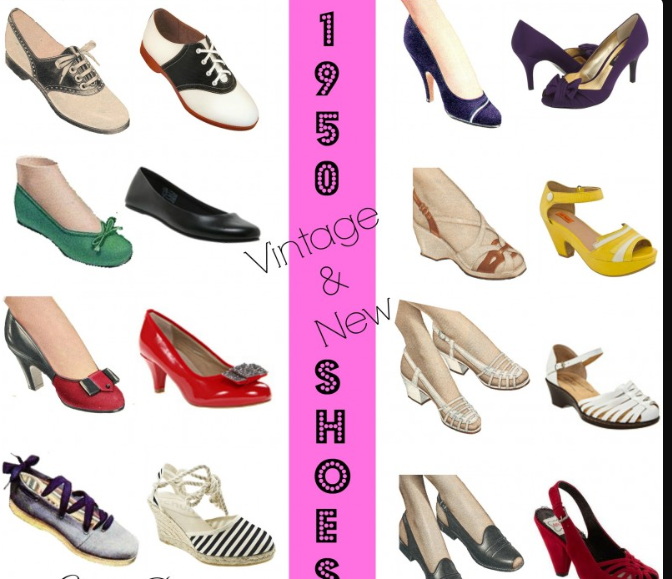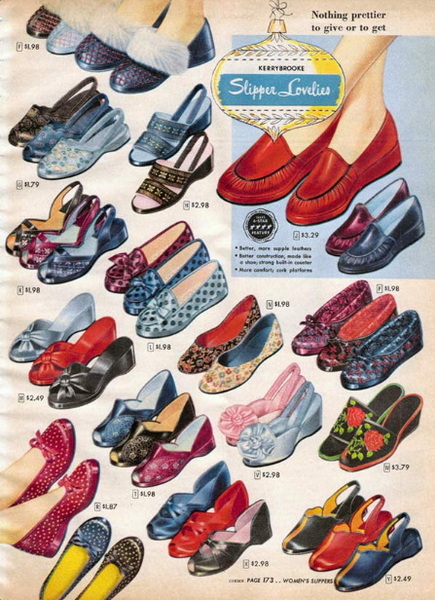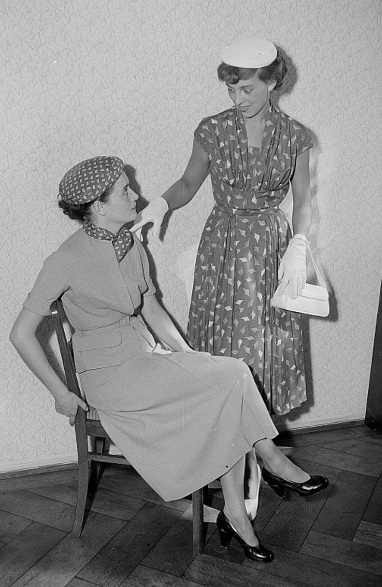Content Menu
● The Rise of Stiletto Heels
● Classic Pumps
● Ballet Flats
● Wedge Shoes
● Saddle Shoes
● Loafers and Moccasins
● Sandals
● Boots
● Innovations in Footwear
● Cultural Influences on Footwear
● Social Changes Impacting Footwear Choices
● Conclusion
● FAQ
>> 1. What types of shoes were most popular among women in the 1950s?
>> 2. Why did stiletto heels become so popular during this decade?
>> 3. Were there any practical shoe styles for everyday wear?
>> 4. How did cultural influences affect women's shoe choices in the '50s?
>> 5. What innovations occurred in shoe manufacturing during this time?
The 1950s was a transformative decade for women's fashion, characterized by a return to femininity and glamour following the austere years of World War II. This era saw significant changes in women's footwear, reflecting broader social trends and innovations in design and materials. From elegant high heels to casual loafers, the variety of shoes worn by women during this period was vast and vibrant.

The Rise of Stiletto Heels
One of the most iconic footwear trends of the 1950s was the stiletto heel. These shoes featured long, slender heels that could reach heights of up to four inches. Designers competed to create the thinnest heels, which allowed women to appear taller and more elegant. However, the allure of these shoes came at a cost; many women found them uncomfortable for prolonged wear.
- Stiletto Characteristics:
- Height: Typically 3-4 inches.
- Design: Often open-toed with a streamlined silhouette.
- Popularity: Became a staple for evening wear.
Stiletto heels were often paired with elegant dresses for formal occasions, making them a must-have in every woman's wardrobe. The combination of stiletto heels with fitted dresses accentuated the hourglass figure that was highly sought after during this decade.
Classic Pumps
Pumps, known as court shoes in some regions, remained a popular choice throughout the decade. These shoes were characterized by their closed toe and low-cut sides, often featuring a modest heel. By the mid-1950s, variations like the "opera pump" emerged, which had a lower heel and wider toe box.
- Pump Features:
- Styles: Varied from almond-shaped to pointed toes.
- Colors: Predominantly black and brown, with some brighter options for summer.
Classic pumps were versatile enough to be worn in both professional settings and social gatherings. Women often chose pumps to complete their outfits for work or casual outings, making them an essential part of everyday fashion.
Ballet Flats
Ballet flats gained immense popularity during the 1950s, particularly after actress Audrey Hepburn showcased them in films such as *Roman Holiday*. These shoes were typically flat with very little heel and often featured decorative bows. They were favored for their comfort and versatility, making them suitable for both casual and semi-formal occasions.
- Ballet Flat Details:
- Style: Simple design with minimal embellishments.
- Common Colors: Black was especially popular, but other colors were also available.
Ballet flats became synonymous with a chic yet effortless style. Women paired them with everything from tailored trousers to flowing skirts, embodying the spirit of freedom that characterized post-war fashion.
Wedge Shoes
Wedge shoes were another significant trend of the decade. These shoes featured a solid heel that extended from the front to the back of the shoe, providing both height and stability. They were available in various styles, including peep-toe designs that became popular for summer wear.
- Wedge Characteristics:
- Heel Type: Chunky and sturdy.
- Design Variations: Included open-toe styles with larger toe openings.
Wedges offered a practical alternative to stilettos while still providing elevation. They became particularly popular among women who wanted to maintain comfort without sacrificing style during outdoor events or casual outings.
Saddle Shoes
Saddle shoes became synonymous with teenage fashion in the 1950s. These two-toned Oxfords were often worn with bobby socks and poodle skirts, making them a staple among young girls. Saddle shoes were not only stylish but also practical for everyday wear.
- Saddle Shoe Features:
- Color Combinations: Typically black and white or brown and white.
- Style: Laced Oxford design.
Saddle shoes reflected the youthful exuberance of the era's youth culture. They were often associated with rock 'n' roll music and dance events, further embedding them into the cultural fabric of the time.
Loafers and Moccasins
Loafers and moccasins were popular casual footwear choices during this decade. They offered comfort and ease of wear, making them ideal for everyday activities. The penny loafer, characterized by its decorative leather strap across the top, was particularly favored by young women.
- Loafer Details:
- Style Variations: Available in various colors and materials.
- Practicality: Easy to slip on and off.
Loafers were versatile enough to be worn with both casual outfits like jeans and more polished looks involving skirts or dresses. Their practicality made them favorites among working women who needed comfortable yet stylish footwear for long hours.

Sandals
As fashion evolved throughout the decade, so did sandals. By the late 1950s, sandals began to show more skin than their predecessors from earlier decades. Strappy designs with thin heels became fashionable for evening wear, while chunkier styles remained popular for day use.
- Sandals Overview:
- Evening Styles: Featured ultra-thin straps and heels.
- Day Styles: More substantial with thicker straps for comfort.
Sandals represented a shift towards more relaxed styles as summer approached. Women embraced these airy designs during vacations or beach outings, showcasing their pedicured feet in vibrant colors.
Boots
While high heels dominated much of women's footwear in the 1950s, boots also had their place. However, these were generally not the high-fashion boots seen today; instead, they included practical options like fur-lined work boots or galoshes designed to protect against rain or snow.
- Boot Features:
- Types: Included casual work boots and rubber galoshes.
- Functionality: Designed for weather protection rather than style.
Boots served a dual purpose—providing warmth during colder months while still allowing women to express their personal style through various designs and colors available at that time.
Innovations in Footwear
The shoe industry experienced remarkable growth during the 1950s, breaking production records year after year. In fact, over 576 million pairs of shoes were produced in the U.S. alone by 1955. This boom was fueled by innovations in materials and construction techniques that improved comfort and fit.
- Key Innovations:
- New lasts provided better flexibility.
- Lightweight materials made shoes easier to wear.
Additionally, advancements in synthetic materials allowed manufacturers to create more affordable options without compromising on style or durability. This democratization of fashion meant that women from various backgrounds could access trendy footwear that reflected contemporary styles.
Cultural Influences on Footwear
The cultural landscape of the 1950s greatly influenced footwear trends. The rise of Hollywood glamor brought attention to stylish footwear as essential components of fashionable outfits. Celebrities like Marilyn Monroe and Audrey Hepburn set trends that many women aspired to emulate.
- Celebrity Impact:
- Stars showcased new styles on-screen.
- Fashion magazines highlighted these trends extensively.
Movies played an integral role in shaping public perception about what constituted fashionable footwear; many viewers sought out similar styles worn by their favorite actresses as they sought to replicate that glamorous lifestyle at home.
Social Changes Impacting Footwear Choices
The post-war era saw significant social changes that affected women's roles in society. As more women entered the workforce during this time period—often taking on jobs traditionally held by men—there was an increasing demand for functional yet stylish footwear suitable for office environments.
- Workplace Fashion:
- Shift towards professional attire influenced shoe choices.
- Comfort became paramount as women balanced work-life demands.
This shift paved the way for more practical designs like loafers or low-heeled pumps that could transition seamlessly from office settings into social engagements after hours without sacrificing elegance or professionalism.
Conclusion
The shoes worn by women in the 1950s reflected a blend of elegance, practicality, and emerging fashion trends that defined a generation. From glamorous stilettos to comfortable loafers, each style played a role in shaping women's fashion during this vibrant decade. As we look back on these iconic styles today, we can appreciate how they paved the way for future fashion innovations while celebrating femininity and personal expression through footwear.

FAQ
1. What types of shoes were most popular among women in the 1950s?
The most popular types included stiletto heels, pumps, ballet flats, saddle shoes, loafers, wedges, sandals, and boots.
2. Why did stiletto heels become so popular during this decade?
Stiletto heels became popular because they enhanced height and elegance, aligning with the era's emphasis on femininity and glamor.
3. Were there any practical shoe styles for everyday wear?
Yes! Casual styles like loafers, moccasins, saddle shoes, and ballet flats provided comfort while remaining stylish enough for daily activities.
4. How did cultural influences affect women's shoe choices in the '50s?
Cultural influences from Hollywood stars set trends that many women followed; celebrities often showcased fashionable footwear that became desirable among everyday consumers.
5. What innovations occurred in shoe manufacturing during this time?
Innovations included improved materials for comfort and flexibility as well as new construction techniques that allowed for lighter weight designs without sacrificing style or durability.

















